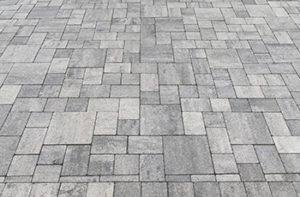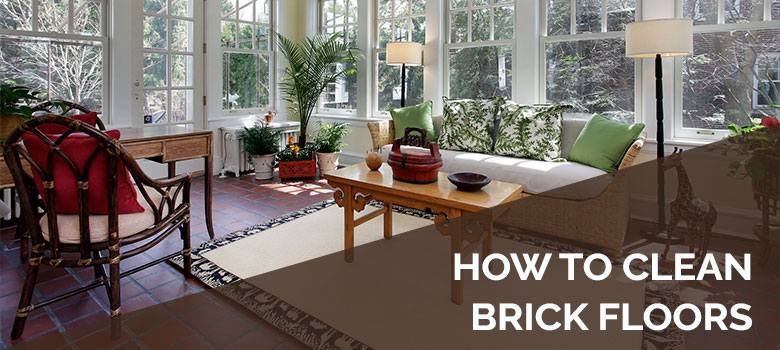Brick floors, like natural stone floors, are a firm favorite with many homeowners. Brick is a durable and long-lasting option at a fraction of the cost of slate or granite floors. But how do you keep that newly-installed look? Learn how to clean brick floors right here!
When cleaning this type of floor, you should keep in mind that brick flooring consists of two components: the actual brick and the grouting lines between each brick.
Cleaning the bricks may be easier than cleaning the narrower grout lines, where debris and dirt become trapped and ingrained. Ineffectively cleaning brick floors can lead to the grouting lines being damaged and deteriorating over time.
While brick floors are hard and virtually indestructible, their surfaces can become marred by sharp objects being dragged across the floor, something hard or heavy falling onto them, or chemicals burning the surface treatment.
You have probably seen how some bricks discolor and react to certain cleaners and how bricks can create a fine powder coating that sifts all over your floor. Employing appropriate cleaning methods and having the right tools and cleaners at your disposal will ensure your brick floor remains clean and looking new.
Everyday Brick Flooring Cleaning Techniques
Brick floors tend to be weakest along their grouting lines. This is where dirt, grit, and other debris collect. For the most part, regular sweeping will not remove this build-up thoroughly. Over time, the grouting wears away, and this means the grout lines become lower than the actual bricks, creating a texture that is difficult to sweep.

Should you be cleaning an older brick floor, assess whether the grout needs replacing. If the grouting is still level with your bricks, you can consider using something like Mapei Grout Refresh Colorant and Sealer, which rejuvenates and seals your grouting. Whether your grouting is in good condition from the start or has been freshly-replaced, you can follow a cleaning routine that cleans your brick floors quite effortlessly.
Sweeping, Vacuuming, And Dry Mopping Brick Floors
Be sure to choose a soft-bristled broom or sweeping machine to clear away dust, grit, and other particles from your bricks and grouting. If you hear scraping, you should lighten your approach. Apply less pressure, letting the broom or machine glide across the floor.
Remember, brick floors can scrape and scratch if something gets caught in the bristles of your broom. Inspect your cleaning equipment if you hear any abrasive sounds.
When vacuuming, you should use a fitting that has a soft-bristled attachment and avoid beater bars, which may cause your bricks to chip and crack. While a brick floor is hearty, it can easily become pitted and cracked when exposed to excessive vibration. Vibration from a heavy-duty vacuum machine can also cause the grouting to disintegrate, causing brick dust and unsightly cracks between bricks.
As a guide:
- Sweep or vacuum in one direction. This means you use a sweep, lift, return, sweeping motion. Sweeping back and forth will create a sand-paper effect, scraping off the sealant layer.
- Use soft gliding motions. Don’t drag or push the broom, sweeping machine, or vacuum cleaner.
- Work from one end to the other end of a row of bricks before moving over to a new section.
- When you are finished, you may want to clean up from the other angle of the floor to clean out the diagonal grouting lines you may have missed.
Weekly Techniques To Clean Your Brick Floors
While cleaning with a broom or vacuum daily will ensure your floor remains cleaner for longer, you will need to wash your floors weekly to maintain shine and promote good hygiene.
Using a high-quality mop and appropriate cleaning solution can help you to achieve a professional finish in no time at all.
Mopping And Washing Solutions Your Brick Floors Will Love
Mopping can be done with a range of cleaning solutions, from simply using clean water to adding a few tablespoons of appropriate cleaning fluid to the mix. So, what cleaning liquids can you use?
- Vinegar: Add a few tablespoons of vinegar to the mopping water, but take care not to create an acidic solution that may cause your bricks to react chemically or become pitted due to chemical erosion.
- Baking soda: By adding one to two tablespoons of baking soda to one gallon of water, you can also create a good cleaning solution for your brick floors.
- Borax powder: As an alternative to baking soda, you can add two tablespoons of borax powder to one gallon of water as a cleaning solution.
- Commercial cleaning solutions: There is a range of commercial cleaning solutions you could consider using; however, check first whether they are suitable for brick floors before adding these to your cart. I like Sheiner’s – Stone and Tile Cleaner, Ready-to-Use Multipurpose Cleaner.
Using a patio brick cleaner like Scotts Outdoor Cleaner Patio & Deck with ZeroScrub Technology Concentrate is great since it requires little effort and can be used with a hose attachment.
When mopping, you should again consider the directionality of your floor. Follow the bricks’ length and change your mop strokes’ direction based on the grout lines as you did when sweeping.
If your brick floor has lowered grout lines, you may need to use a wetter mop and more vigorous scrubbing to get into the crevices. This could cause a build-up of soap on the corners of the bricks, so you should then mop the floor a second time with clean water (thus removing soapy residue) before allowing it to dry.
Drying your brick floor is vital. If you leave excessive amounts of water to stand on it, you risk molding developing as the water penetrates the bricks themselves.
Use fans or AC units to help your brick floor dry more quickly, or you can also use a lint-free cloth to absorb any excess liquid. Dry mopping also helps.
Mopping Brick Floors Guide: Dos And Don’ts
- Do use a mild and slightly alkaline cleaning solution to clean your brick floors. Avoid adding acidic cleaners or excessive vinegar to your mop water.
- Do mop in one direction, moving the mop forwards and backward, but not in circular motions. If using a mop pad, work only in one forward direction.
- Do mop a second time with clean water to remove soapy residue, or dry mop to help speed up the drying time.
- Do rinse your mop frequently. A large floor may require you to use a second bucket with a cleaning solution.
- Don’t sweep or mop so vigorously that you break off sections of the brick floor or scrape smaller grit particles across the surface.
- Don’t use a steam cleaner to clean a brick floor, as this may cause the brick to become brittle and crumble.
Brick Floors: Whether Or Not To Reseal And Regrout
Newly-installed brick floors are certainly easier to maintain than those that have aged. However, how do you clean an older brick floor that has been worn down over time? For new homeowners, this can be a struggle.
Once mold has taken hold, no amount of mopping will help, but cleaning the grout lines with a good commercial grout cleaner will add some life back into your brick floors. Be sure to seal your grout lines once you have cleaned if the cleaning product doesn’t double as a sealant.
To add life and luster, reseal the floor. Resealing a brick floor is a tricky endeavor as you will have to either chemically or manually strip off the existing sealant layer. This can reveal your brick floor’s original coloring, but it can also damage the floor’s surface, leaving your only option to paint the floor and then seal it.
If you don’t know what sealing product was used on your floors previously, finding a chemical stripper that will work without damaging your bricks can be challenging.
Should you choose to resurface your brick floor yourself, then you will need to ensure you clean it thoroughly using the sweep, mop, rinse, and dry methods above before applying new layers of sealant. Follow instructions provided by the sealant manufacturer regarding curing and drying times.
Correctly applying the sealant is where the difference lies between a potentially professional finish and something that is–literally–tacky.
Brick Floor Cleaning FAQs
After sweeping off any dirt and dust, clean the floor with a mop and a bucket. You can mix either one cup of ammonia or ¼ cup of commercial brick cleaner with eight cups of warm (but not boiling) water in the bucket. Mop with a moderately damp mop and allow to air-dry. If necessary, you can rinse with fresh water before drying.
Does Powerwash Damage Brick Floors?
While it may seem like a good idea to use a power washer on faded brick floors, this is not advisable. Bricks are made from a composite slurry, so exposing them to a high-pressure stream of water and/or chemicals can cause the brick to disintegrate and crumble.
Instead, focus on using no more than 100 psi to 1500 psi of water pressure. As an indication of how much this is, a garden hose usually yields 40 psi of pressure. Rental power-washing machines tend to produce streams of 3,000 psi and upwards. This can rip your bricks apart.
Can I Seal My Brick Floors?
Yes, you can and should seal brick floors once they have been thoroughly cleaned. This helps the floor to be less gritty, ensuring less powdery residue that can be tracked through the rest of your home.
To seal a brick floor, you may choose a deep-penetrating sealant, which helps preserve your floor’s natural color. This is great in areas with lots of sun exposure. You could also choose a film-forming sealant, which is excellent for achieving a higher-gloss finish. Be sure to follow the manufacturer’s guide to achieve a professional finish.
How Do You Take Care Of A Brick Floor?
Begin by using a regular cleaning routine of daily sweeping and weekly mopping. This will remove everyday dirt before it can create build-up. Weekly mopping will ensure your brick floors are clean and bright.
Should You Seal Brick Floors?
Yes. Bricks are porous, meaning they absorb liquids. If you want to avoid stains, then you should seal your bricks to make them more liquid-repellent. This will help your bricks resist water and liquid spills like wine or juice, and they will be less likely to absorb food messes.
The Final Sweep
Cleaning a brick floor can be a challenge when you don’t perform the required maintenance. But if you clean spills immediately and prevent sticky residues from forming, you can reduce the need to scrub and deal with stubborn stains down the line. A daily sweeping or vacuuming routine followed by a weekly mopping will keep your brick floors vivid and clean.
Choosing the right cleaning solution for your brick floors will help you maintain the finish and add luster to the surface treatment. As a result, your brick floors will hold up better over time.
Whether your brick floor is inside or on an outside patio, you need to clean it appropriately or expect to face higher costs later when you need to resurface your bricks or regrout the grooves due to inappropriate or inadequate cleaning techniques.
Have you used the techniques or cleaning solutions described in this article when cleaning your brick floor? Share your experience in the comments section or leave an image or opinion of your brick floor cleaning adventures on our social media.
Back to Top